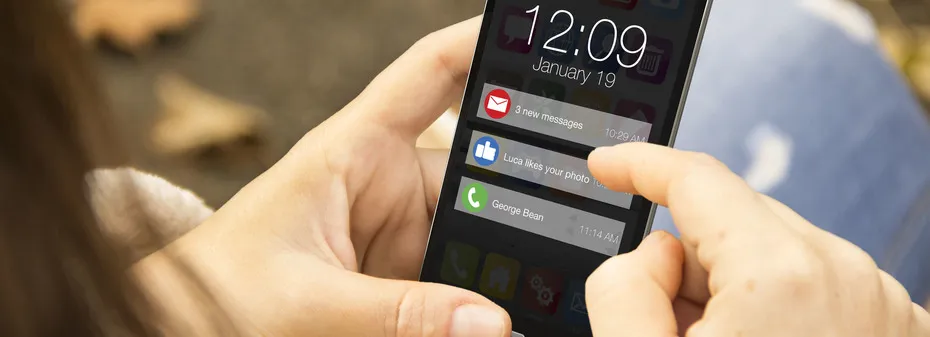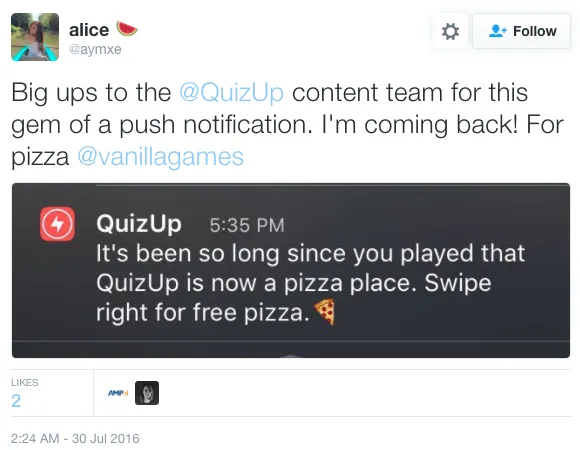
Push Notifications: Don’t Let Users Forget about Your App

The goal of every mobile business app is to become a part of the user's daily life. You may have hundreds of applications on the phone, but most of them are rarely used, if ever launched. Only a small part of apps are used daily. Of course, every entrepreneur dreams, that his/her app become a necessity for a majority of newcomers. How to achieve this?
Push notification integration is the answer.
Push notifications are more effective than emails, as they are more user-oriented, help to create a smooth flaw back to your app and, more importantly, are more engaging.
4 Categories of User Behaviour
Before you start thinking about how to create the perfect push notification, you need to understand how consumers use the app. It is important to know who already use it, and who needs to be re-interested in it, as well as which users entered your app for the first time.
In other words, you need to find out which of the following four categories each user belongs to and how you can engage them more.
Newbie
These are new users. They see, try and use your app for the first time. In a few hours or, perhaps, in a few minutes these "newcomers" will decide whether your product deserves attention. Ultimately, they will either decide to delete the app, and they will fall into the category of passerby, or engaged, or, sometimes, dormant users. Your task is to turn them into engaged and convince not to uninstall the app.
Passerby
This category includes 23% of users who used your app several times, but eventually opted for another. Once they remove the application, you lose the ability to send them Push notifications. However, users of the passerby category can still be of value. First, they have a lot of information about what your product did not provide them. Secondly, it is a good way to calculate the user outflow rate, as well as an excellent opportunity to assess the overall success of your app.
Engaged
These are people who consider your application one of their favorites. They often use it, most likely every day. They represent the most important category of users to which an individual approach needs to be applied to maintain a high level of interest. Stimulating such interest through Push notifications requires certain creative skills.
Dormant
This is the category of people who were once engaged in your app, but later lost interest in it. Perhaps they do not have time, or they use other applications, or maybe they just forgot about it. Whatever the reason, these users need to be given a boost so that they can use this program again.
Leveraging Data when Creating User-Centric Push Notifications
Your push notifications should be customer-oriented. The type of message that you send to the Dormant user will be different from the one you send to the Engaged one. To better understand your users and find out which category of behavior each user belongs to, you need to obtain information about their degree of interest.
Analysing information is the best way to get a full picture of each individual user. Unfortunately, studies have shown that 95% of the data within the business model remains unreached. In any case, all users differ from each other: they interact differently and have different preferences.
The more you know about your users, the more personalised Push notifications you can make. If push notifications are not personal, 94% of consumers simply delete your messages.
When you need to improve the quality of customer service, especially in mobile applications, there are useful starting points that you need to take into service:
- Timing
- Location
- Preference
- Behavior
- Device
Timing
In the past, companies sent all their marketing messages at certain time of the day. The general opinion was that most users are active at 9 am, which made this time the most favorable for mailing. But most is not all, and the success of such mailing is sharply reduced. Consumers want to interact with apps at a time convenient for them, not for you. If you know when each user is working with the app or browsing web pages in the phone, it will be crucial to choose the time of sending your notifications.
Location
The most useful thing in an app that uses location data is knowing when your customers are physically near your store. This knowledge is necessary in order to offer them a rush notification of promotions, information or discounts. Keep in mind that almost half of mobile phone users are in favor of push notifications based on location-based, because they find them useful. So make sure that you provide them with the information they need.
Airlines have succeeded by sending push notifications in order to inform passengers about the gate exit number change or the delay in the flight.
Preferences
There is nothing more important than an individual approach when satisfying the preferences of your users. The popular scientific magazine The Harvard Business Review notes that consumers 40% more buy from those who make individual offers. People need information, products, playlists, images, etc., which they personally think are the most interesting.
For example, if your app provides sports news, your push notifications should only concern your favorite user commands. Do not burden him with news about the teams he does not care about. The same goes for the Push notifications regarding new products or discounts.
Behavior
Do not impose a "buy now" type notification to a new customer, as this will look like spam. Instead, you should send notifications that inform new users about the various functionality of the app that they may not be aware of. Different types of user behavior also show how they use your app. Perhaps they do not see the need or do not want to use every function; perhaps they use it only for one purpose. In this case, you can provide notifications specifically for this category of users.
Device
This issue may not be given enough attention, but it is very important when during development you consider different devices. Most of us, even if we do not realise this, have an established schedule of when we use each of our devices.
We can use smartphones when we just wake up, but later in the morning switch to the tablet before start working on the office laptop or again take the phone in hand. Push notifications can be perceived as spam or annoying when a user receives the same information on each of their devices. When you intend to send a Push notification, you must send it to one device, which the user is most likely to use at the moment.
Plan, Experiment, Test and Re-Test

Push notifications should increase the customer's perception of the service quality, and not have a negative impact on it. Every user receiving a notification should be glad that he received it. The receipt of the notice should be of some value.
Again, we remind that non-individual mailings, "spray and pray", are no longer a reliable strategy. In fact, they can carry more danger and destroy the positive experience. Statistics show that people can delete your app after 6-10 useless messages.
Perfecting Your Notifications
As every job, crafting notifications needs practice. It is necessary to carry out a large amount of planning work. Before you send a message, ask yourself three questions:
- What is the purpose of this message? (Reduce the outflow of customers, increase mobile sales, improve the filling of the shopping basket, introduce new products, etc.)
- Does it achieve this purpose?
- Does it achieve it in a way that the user will like and estimate?
Analytics
Another important step is to evaluate positive results using real indicators.
- Click through rate
- Engagement rate
- Secondary action rate
- Sharing metrics
- Sales growth rate
- Lead growth
- Number of sales
- Re-engagement
Push notifications are designed to achieve many goals, although they have very limited scope. So, even minor changes in the word choice and message delivery timing can be of great importance. In order to overcome this problem, you need to study different messages and at the same time determine how each of them affects the audience.





